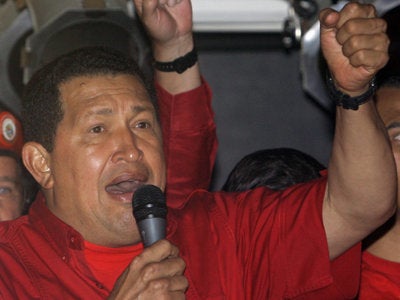
Reposted from Foreign Policy In Focus
The alleged support by the United States of wealthy landowners, business leaders, and their organizations tied to the violent uprising in eastern Bolivia has led U.S. Ambassador Philip Goldberg's expulsion from La Paz and the South American government's demands that the United States stop backing the illegitimate rebellion. Goldberg had met with some of these right-wing oppositionist leaders just a week before the most recent outbreak of violence against the democratically elected government of Evo Morales, who won a recall referendum in August with over 67% of the popular vote.
U.S. subversion has assumed several forms since the leftist indigenous leader became president in 2005. For example, the U.S. embassy — in violation of American law — repeatedly asked Peace Corps volunteers, as well as an American Fulbright scholar, to engage in espionage, according to news reports.
Bolivia gets approximately $120 million in aid annually from the United States. It's an important supplement for a country of nine million people with an annual per capita income of barely $1,000. Presidential Minister Juan Ramón Quintana has accused the U.S. Agency for International Development (USAID) of using some of this money to support a number of prominent conservative opposition leaders as part of a "democracy initiative" through the consulting firm Chemonics International. A cable from the U.S. Embassy in Bolivia last year revealed a USAID-sponsored "political party reform project" to "help build moderate, pro-democracy political parties that can serve as a counterweight to the radical MAS or its successors" (MAS stands for Movimiento al Socialismo, the party to which Morales belongs.). Despite numerous requests filed under the Freedom of Information Act, the Bush administration refuses to release a list of all the recipient organizations of USAID funds.
Decades of Intervention
The history of U.S. intervention in support for rightist elements in Bolivia is long. The United States was the major foreign backer of the dictatorial regime of René Barrientos, who seized power in a 1964 military coup. The CIA and U.S. Special Forces played a key role in suppressing a leftist peasant uprising that followed, including the 1967 murder of Ernesto "Che" Guevara, a key leader in the movement.
When leftist army officer Juan José Torres came to power in October of 1970, the Nixon administration called for his ousting. When an attempted coup by rightist general Hugo Bánzer Suárez was threatened by a breakdown in the plotters' radio communications, the U.S. Air Force made their radio communications available to them. Though this first attempted takeover was crushed, Bánzer was able to seize power by August of the following year in a bloody uprising, also with apparent U.S. support. Thousands of suspected leftists were executed in subsequent years.
The United States largely supported Bánzer and subsequent dictators in the face of a series of protests, general strikes and other largely nonviolent pro-democracy uprisings, which eventually led to the end of military rule by 1982 and the coming to office of the left-leaning president Hernán Siles Zuazo. The United States refused to resume economic aid, however, until the government enacted strict neoliberal austerity measures.
Democratic Bolivia
A series of center-left and rightist civilian governments ruled the country over the next 20 years, most of which were corrupt and inept and none of which could come close to meeting the basic needs of ordinary Bolivians, who — with the exception of the Haitians — are the poorest in the Western hemisphere. Despite the restoration of democracy, the strict austerity programs pushed by the United States and the International Monetary Fund (IMF) resulted in the Bolivian people, more than two-thirds of whom live in poverty, having little say in the decisions that most impacted their lives. Furthermore, even though the majority of the population is indigenous, the country's leaders continued to be white or mestizo (of mixed-race heritage).
The 2005 election of Evo Morales, a left-wing activist and the first indigenous leader in the nearly 500 years since the Spanish conquest, marked a major shift in Bolivia's politics. His commitment to a radical reform of the country's inequitable social and economic system has proven to be even more critical than his racial and cultural identity.
To understand Bolivian sensitivities to U.S. aid and its conditions, as well as concerns regarding U.S. intervention, it is important to look at what happened to Bolivia's first leftist government, which governed back in the 1950s.
Undermining the 1952 Revolution
In 1952, a popular uprising against a rightist military regime led to the left-leaning nationalists of the Movimiento Nacionalista Revolucionario (MNR) coming to power promising political freedom and radical economic reform. As with Morales and MAS, his political party, that revolutionary government had strong support from militant worker and peasant political movements. And, also like today, the new government's policies were strongly nationalistic, particularly in regard to the country's natural resources, in which U.S. investors had substantial interests.
It wasn't long, however, before the United States forced a dramatic shift in the regime's priorities.
With its landlocked location, dissipated gold reserves, increased costs of production and imports, and huge trade deficits, Bolivia's revolutionary regime couldn't counter the economic power of the United States. U.S. aid wasn't enough to improve the standard of living in Bolivia, but it did manage to make the country more dependent. The Bolivian Planning Board noted that "rather than an impulse to improvement, the aid has represented a means only of preventing worse deterioration in the situation as it existed."
The ruling MNR recognized that it couldn't afford to anger Washington. Their fear stemmed not just from the threat of direct intervention (like what took place in Guatemala against the nationalist Arbenz government less than two years later), but also from the fear of economic retaliation, not an unimportant concern given Bolivia's dependence on the U.S. to process its tin ore and provide needed imports.
Dependency
Indeed, it was clear from an early stage of the revolution that the economic weakness of Bolivia, combined with the economic power of the United States, allowed the U.S. to establish clear parameters for the revolution. For example, the United States forced Bolivia to pay full compensation to the wealthy foreign owners of recently nationalized tin mines rather than use the funds for economic development. The Petroleum Code of 1955, written by U.S. officials and enacted without any public debate or alterations by Bolivian authorities, forced the Bolivian government to forego its oil monopoly. Bolivia was then forced to sign an agreement to further encourage U.S. investment in the country. It was due only to this desperate need for an additional source of foreign exchange and pressure from the U.S. government that the once strongly nationalistic MNR agreed to these concessions.
The following year, the U.S. took more direct authority over Bolivia's economy by imposing an economic stabilization program, which the Bolivian government agreed to, according to U.S. officials, "virtually under duress, and with repeated hints of curtailment of U.S. aid" (This quote is from Inflation and Development in Latin America: A Case History of Inflation and Stabilization in Bolivia, a book by George Jackson Eder.). The program, which bore striking resemblance to the structural adjustment programs which have since been imposed on dozens of debt-ridden countries in Latin America and elsewhere, consisted of the devaluation of the boliviano; an end to export/import controls, price controls and government subsidies on consumer goods; the freezing of wages and salaries; major cutbacks in spending for education and social welfare; and an end to efforts at industrial diversification.
The result, according to U.S. officials which forced its implementation, "meant the repudiation, at least tacitly, of virtually everything that the Revolutionary Government had done over the previous four years." It not only redirected the economic priorities of the revolution, particularly its efforts at economic diversification, but altered the revolution's political structure by effectively curbing the power of the trade unions and displacing socialist-leaning leaders of the MNR.
In the end, the United States was able to overthrow the Bolivian revolution without having to overthrow the government.
Structural Adjustment
In many respects, U.S. policy towards Bolivia proved to be a harbinger for future U.S. domination of Latin America in this age of globalization, where the so-called "Washington consensus," backed by U.S.-supported international financial institutions, created a situation where even wealthier Latin American countries had as few choices in choosing their economic policies as did impoverished Bolivia during the 1950s.
This has begun to change, however. Thanks in part to Venezuela's oil wealth and the willingness of Venezuelan president Hugo Chávez, in the name of Latin American solidarity, to help its poorer and financially-strapped neighbors, a number of Latin American governments have had their debts reduced or eliminated. The strengthening of regional trade blocs and increased trade with Europe and China has also made it easier for South American nations to wean themselves from dependency on the United States.
Under Morales, Bolivia has attempted to strengthen the Andean Community of Nations and the signing last year of a "People's Trade Treaty" with Venezuela, Nicaragua, and Cuba is indicative of the desire to strengthen working economic and political alliances outside of direct U.S. influence in order to be better able to stand up to Washington.
As a result, Morales and the MAS seem better positioned to withstand economic pressure from the United States. Unlike the MNR in the 1950s, Morales comes out of a popular mass movement of the country's poor and indigenous majority, which is very different than the predominantly white middle-class leadership of reformist officers under the previous government. Combined with economic support from oil-rich Venezuela and Morales' efforts at strengthening its economic relationships with Bolivia's Latin American neighbors, MAS has made it possible for the Bolivians to resist buckling under the kind of pressure imposed by the United States a half-century earlier.
The Current Uprising
It's this very ability to better withstand the kind of economic pressures the United States had until recently been able to exert, either directly or through international financial institutions, which has led to recent violence in Santa Cruz and elsewhere in the wealthier white and mestizo-dominated eastern sectors of the country. As a result of the reduced leverage of their friends in Washington, which had previously enabled them to rule the country, certain elite elements now appear willing to violently separate themselves and the four eastern provinces in which they are concentrated.
With much of Bolivia's natural gas wealth located in the east, and taking advantage of the endemic racism of its largely white and mestizo population against the country's indigenous majority, now in positions of political power for the first time, these right-wing forces appear ready to either bring down Morales or secede from the country. Earlier this year they sacked and burned government buildings, murdered government officials and supporters, attacked journalists, sabotaged a key natural gas pipeline, and renounced any allegiance to Bolivia's democratically elected government.
While the leadership of the Organization of American States and virtually every Latin American president has condemned the uprising the U.S. government has not, adding to concerns that United States may indeed have a hand in the violence.
The apparent triumph of the neoliberal model of globalization in the early 1990s and the resulting hegemonic domination by the United States over poorer countries — for which Bolivia served as the prototype 40 years earlier — made it appear as if the days of cruder forms of U.S. interventionism in Latin America were a thing of the past.
Recent events in Bolivia, however, may be a frightening indication that this is no longer the case.
